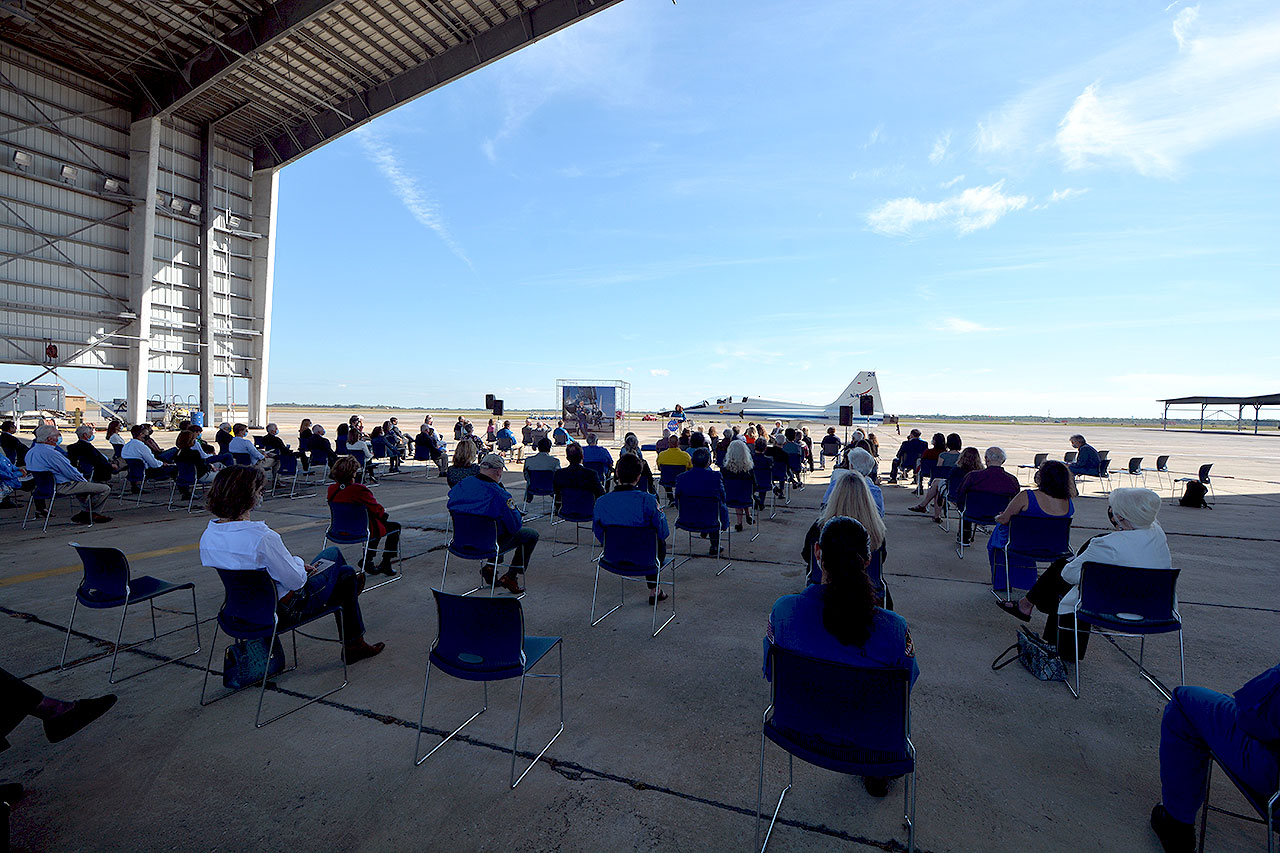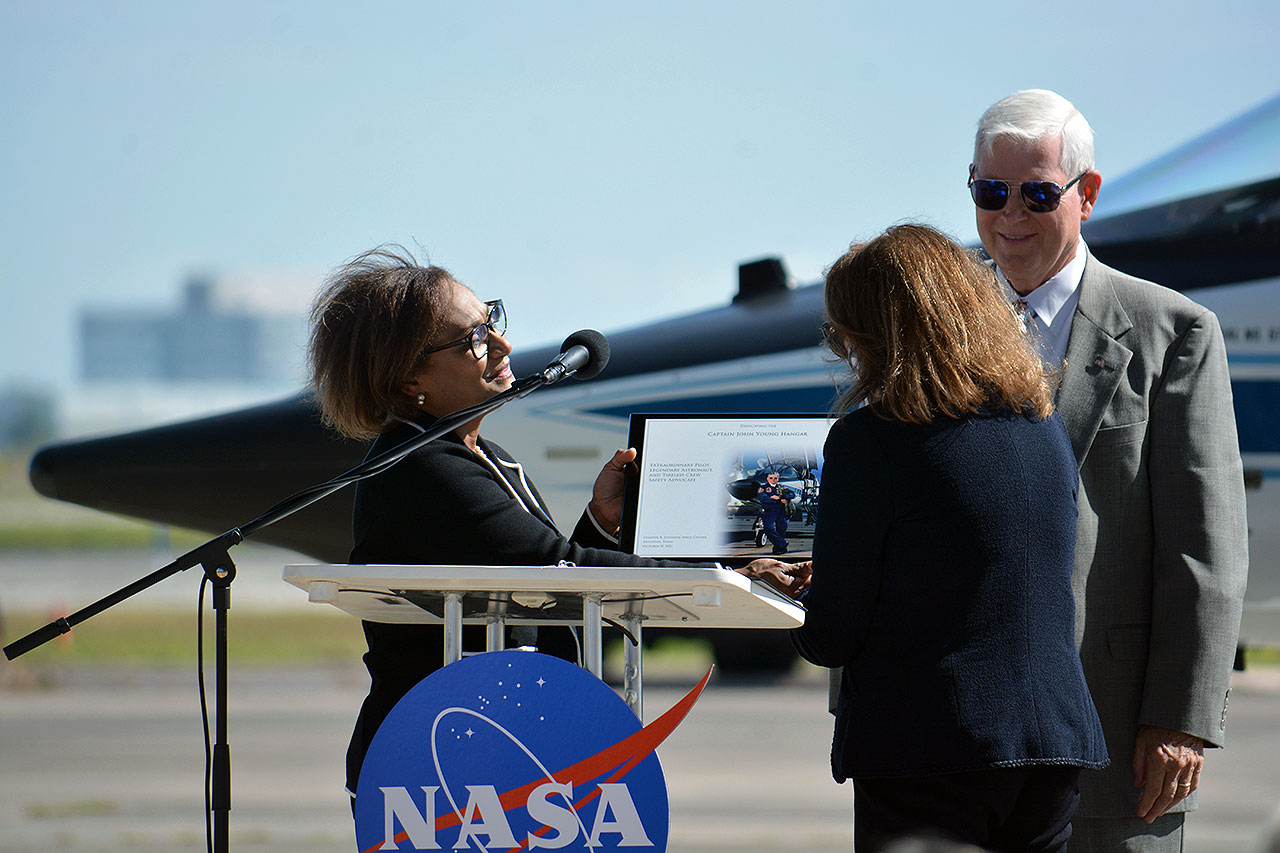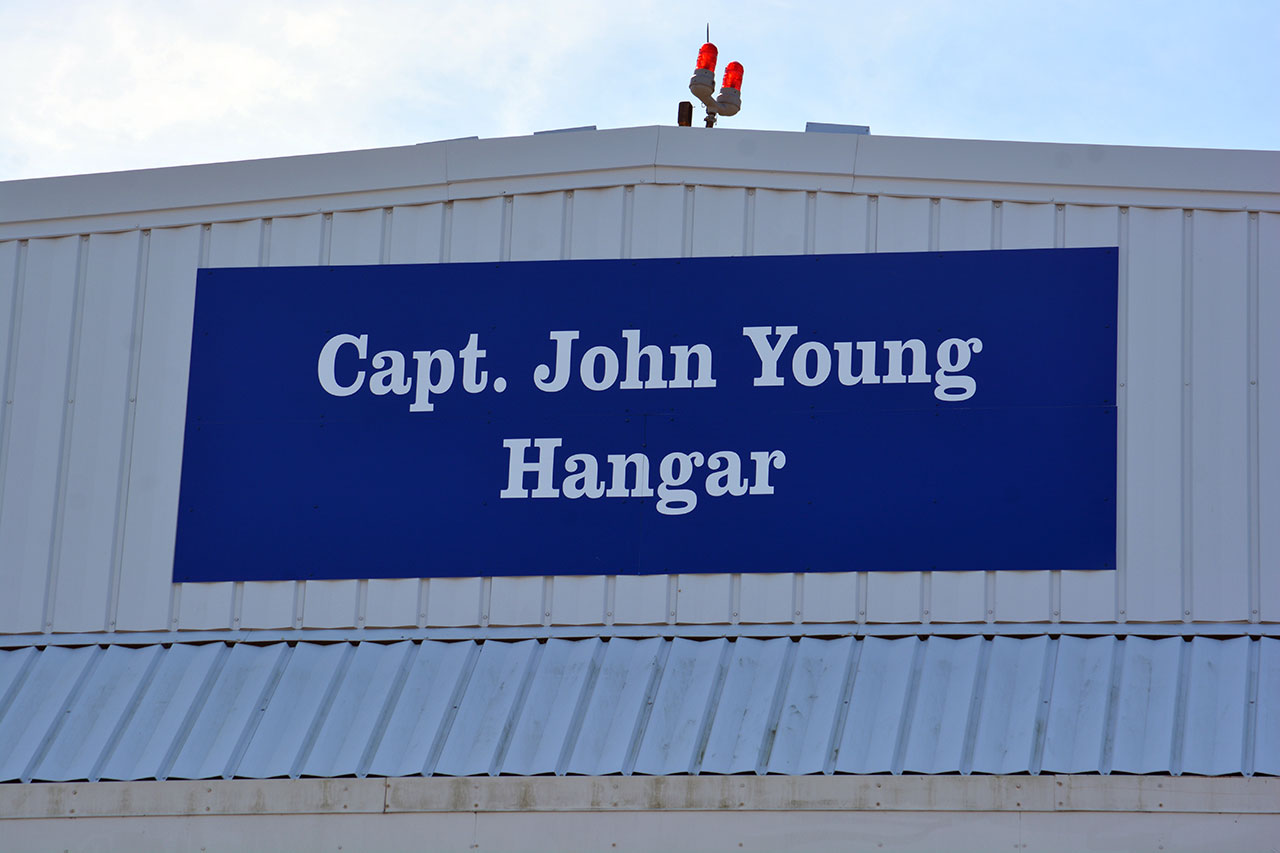Newly-named 'Capt. John Young Hangar' honors legendary NASA astronaut

HOUSTON — NASA's longest-serving astronaut now has his name on one of the space agency's longest-serving structures.
Johnson Space Center director Vanessa Wyche led a ceremony on Tuesday (Oct. 19) to name Hangar 276 at Ellington Field in Houston for the late John Young. A NASA employee for more than 40 years, Young was one of only three astronauts to fly to the moon twice, the ninth person to walk on the lunar surface and the only astronaut (to date) to launch on four different types of spacecraft.
"Hangar 276 has been at the center of flight operations for the United States' astronauts since the inception of our flight program," said Wyche, addressing an audience of current and former astronauts, NASA managers, members of Young's family and other invited guests. "John Young performed a critical role as a pilot and as an astronaut. He also inspired a generation of aviation technicians and engineers who support the projects in and around the hangar."
Hangar 276, which has been in use for more than 60 years, is where NASA maintains its fleet of T-38 supersonic training aircraft. It is also the site where the Johnson Space Center community welcomed home Gemini, Apollo and space shuttle crews after their spaceflights.
Related: John Young in Photos: Astronaut, Moonwalker, Shuttle Pioneer
Adding Young's name to the building is both reflective of the leading role he played within the space agency to ensure flight safety, as well as the need for Hangar 276 for many years to come, according to Wyche.
"We will need to continue to do the training that they do here, going forward into into Artemis," she said, referring to NASA's program to return astronauts to the lunar surface and eventually send them to Mars. "Right now we have these T-38 [jets]. Potentially, in the future, we may be able to get an upgrade to these aircraft, but we will still need to have an aircraft maintenance hangar."
Breaking space news, the latest updates on rocket launches, skywatching events and more!
Many of the jets in the hangar today are the same aircraft that Young flew during his years as a Gemini, Apollo and space shuttle astronaut. One such T-38, tail number 24, served as the backdrop for Tuesday's ceremony, parked adjacent to a large photo of Young posing next to the same vehicle years ago (Young died in 2018 at the age of 87.)
"One of the reasons, for me, for naming this for John Young, was he always emphasized flight safety in everything that he did," Wyche told collectSPACE in an interview following the event. "I worked on shuttle missions and when we would have our flight readiness reviews, he would always be there. He'd always ask the tough questions — the questions that maybe somebody else would not ask."
Joining Wyche in delivering remarks was former Johnson center director Michael Coats, who was also a member of NASA's first class of space shuttle astronauts who trained alongside Young.
"We were constantly asking John to participate in simulations, not just because he was going to be the commander of the first flight [of the shuttle], but because he was an extremely professional test pilot, as well," said Coats. "John was indeed the astronauts' astronaut, but he was also very much the pilots' pilot. Having this NASA aircraft hangar named after him is most appropriate.
Coats and Wyche presented Young's wife, Susy, with a plaque similar to the one that will be hung in the Capt. John Young Hangar. The plaque read in part, "Extraordinary pilot, legendary astronaut and tireless crew safety advocate."
"I think what is really cool about the hangar and his name, is as we get ready to go take that next step through Artemis and go back to the moon, we will think about him," said Suni Williams, an active NASA astronaut. "And think about a person who has been around the world a couple of times and been to the moon a couple of times. He knew a thing or two and we should take [his] lessons."
Related: How John Young Smuggled a Corned-Beef Sandwich into Space
The Capt. John Young Hangar is one of only a few buildings at or run by the Johnson Space Center that are named in someone's honor. The center's Sonny Carter Training Facility, which houses the neutral buoyancy laboratory, and the Jake Garn Mission Simulator and Training Facility also bear astronauts' names.
Young is also honored locally with the Captain John Young Flyover, the bridge that connects State Highway NASA Road 1 to Interstate Highway 45. Florida State Road 423, a highway in Orlando and Kissimmee, is also named for Young, as is an elementary school and planetarium in Orlando. An asteroid bears his name and a Northrop Grumman Cyngus cargo spacecraft flew as the "S.S. John Young" to the International Space Station in 2018.
Coats' son, upon hearing about the ceremony and Young's many achievements, asked why NASA had not named a moon base after him, rather than a hangar.
"I told him maybe it's because we don't have a moon base, yet," said Coats. "But be patient, I fully expect to see John's name on a moon base."
"The John Young moon base may need to wait a while, but I fully expect to see all of you at that dedication," said Coats.
Follow collectSPACE.com on Facebook and on Twitter at @collectSPACE. Copyright 2021 collectSPACE.com. All rights reserved.
Join our Space Forums to keep talking space on the latest missions, night sky and more! And if you have a news tip, correction or comment, let us know at: community@space.com.

Robert Pearlman is a space historian, journalist and the founder and editor of collectSPACE.com, a daily news publication and community devoted to space history with a particular focus on how and where space exploration intersects with pop culture. Pearlman is also a contributing writer for Space.com and co-author of "Space Stations: The Art, Science, and Reality of Working in Space” published by Smithsonian Books in 2018.
In 2009, he was inducted into the U.S. Space Camp Hall of Fame in Huntsville, Alabama. In 2021, he was honored by the American Astronautical Society with the Ordway Award for Sustained Excellence in Spaceflight History. In 2023, the National Space Club Florida Committee recognized Pearlman with the Kolcum News and Communications Award for excellence in telling the space story along the Space Coast and throughout the world.




